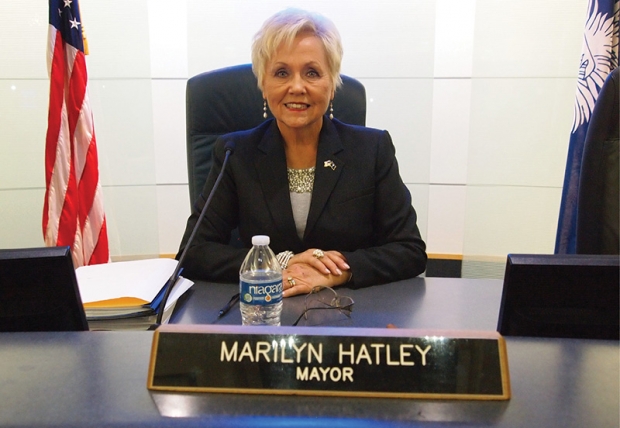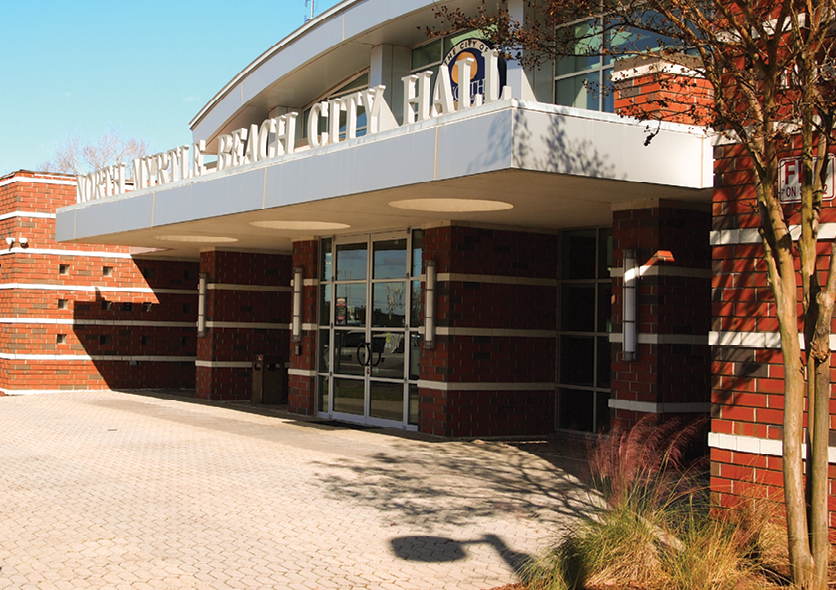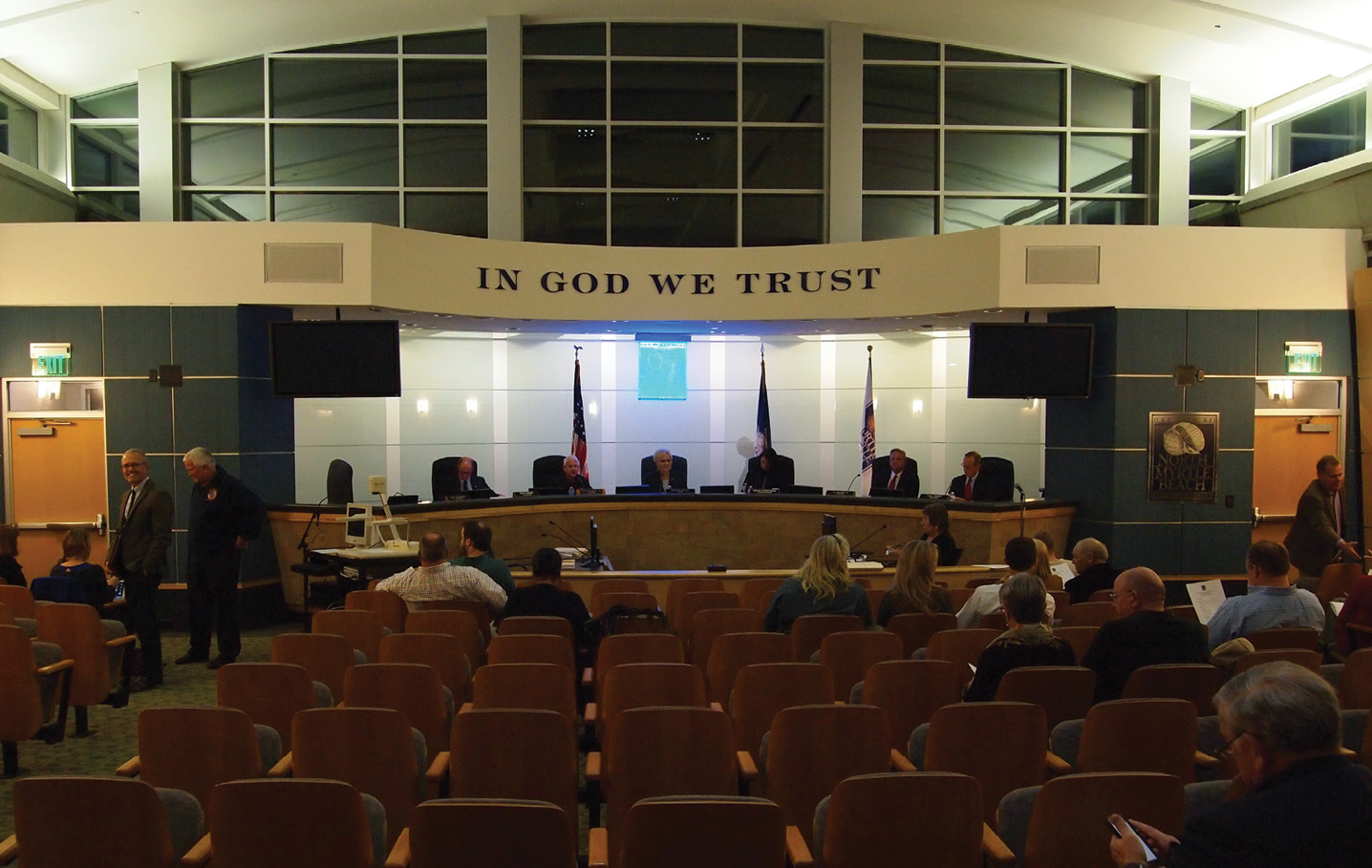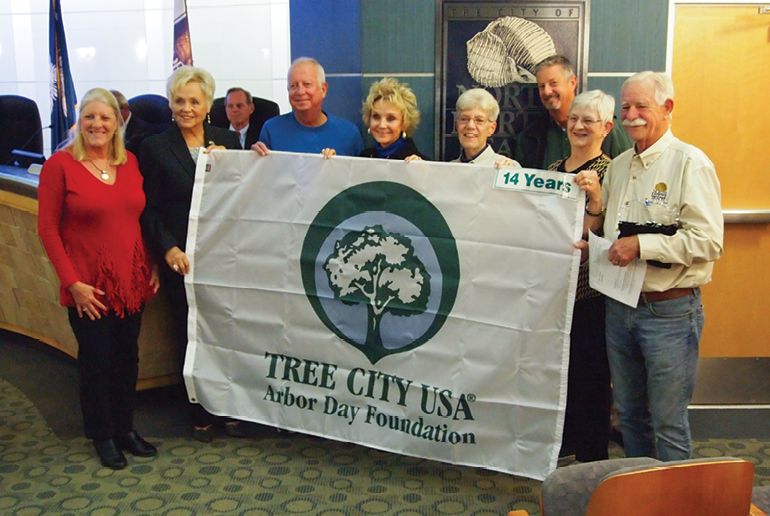A Day in the Life of North Myrtle Beach Mayor Marilyn Hatley

A small city’s mayor, her city manager and a council of elected representatives must find ways to work together for the betterment of the city’s citizens, hundreds of thousands of annual visitors and the unknown future. It takes hard work, commitment and political savvy to make the office of mayor work. In the case of North Myrtle Beach Mayor Marilyn Hatley, it’s an office she’s held for 20 years.
I recently spent the better part of the day with Mayor Hatley in an effort to understand the day-in, day-out workings of a busy city executive who clearly knows how to be a team player and how to get the big job done without sacrificing the little details. Hatley was re-elected to an unprecedented fifth term in 2017, following years of significant growth for the city of 16,000, with expectations for continued exponential growth through the end of her current term in 2021.

1 p.m.
On weekdays when an evening city council meeting is scheduled for that night, Hatley usually checks in to her office just after lunch, which was the case when we first met in the North Myrtle Beach administrative offices. Rarely does her day start in the afternoon or end at 5 p.m., even though the job is supposed to be part-time. “No two days are really ever the same,” says Hatley, sitting behind her desk, smiling as we begin to talk. Over the course of the afternoon, we touch on her past businesses, her career choices going back decades, her family and what to expect in the day ahead as well.
“When the phone rings I answer it,” she says. “We’re always on-call. It is my pleasure and honor to serve, and I am a working mayor, whether it’s meeting business people, our citizens, going to Washington to lobby for federal funds, working on beach re-nourishment, going to Columbia when there’s a need…I stay really very busy.” Pointing to a pair of bright yellow boots and a rolled-up blow-up bed against the wall of her office, Hatley is glad to have squeaked through another hurricane season in 2019 with named storms bringing only minor issues. “We all still have our air mattresses and rain gear left from hurricane season,” she says. “We stay right here working through the worst of it when the weather hits us. There’s no such thing as a part-time mayor,” she continues. “If you’re mayor in a progressive city, you’re working all the time.”

Married to retired pharmacist and developer David Hatley for 51 years, the mayor says her routine, no matter what the day ahead may look like, usually starts in the same way nearly every day. “I get up fairly early, around 6:30 or 7, have a little breakfast, get my coffee, read the [local papers], go online and read the [local outlet] news reports, The State paper, then look at my email and schedule. At some point I meet in person, or by phone, with city manager Mike Mahaney and talk about my schedule and what’s pressing. In fact…” she gets, up looking at the clock, “…come on.” We head down a modern, stylish corridor to Mahaney’s office to check in.
Hatley has an easy air developed by decades in business—she’s a former salon owner—and years in public office. Quick to smile, she speaks with a soft, distinctly Southern drawl that comes from a lifetime living and working in North and South Carolina. Born and raised 35 miles from Charlotte, in the small city of Albemarle, North Carolina, Hatley says she and her family visited Myrtle Beach and North Myrtle Beach many times each summer, like countless families still do. “My mother was a school teacher,” she says, “and we’d have the whole summer off.” Hatley and her husband were “high school sweethearts,” she says. The couple has one son, Chad Hatley, a daughter-in-law, Jackie Vereen Hatley, (who now serves on the city council in Myrtle Beach), and a young granddaughter, who the mayor says she “loves to spoil.”

2 p.m.
Sitting in Mahaney’s office, filled with giant, unruly maps, tubs of bubble gum, an autographed headshot of North Myrtle Beach native and letter-turner Vanna White on the wall, and all the signs of hectic city management, I watch the pair at work. It’s clear the two colleagues are a bonded team. They seem to genuinely like one another and understand the job at hand. Mahaney has been at his post as North Myrtle Beach city manager since 2009, but has worked in the same capacity in other municipalities for 40 years; he knows his stuff. Later that afternoon, out of Mahaney’s earshot, Hatley tells me “Mike is just the greatest. He’s on top of every little detail. We’re a good team because we’re both workaholics. He’s everything you’d want in a city manager.”
“First of all…you got your schedule straight?” asks Mahaney, a no-nonsense, sleeves rolled up, get-the-job-done kind of guy. The mayor flips open her laptop and double-checks the week’s appointments against Mahaney’s itinerary. They haggle over a few items and eventually concur.
Schedule under control, they move to council meeting agenda items. The coming $11.6 million UPS distribution center, to be located off Water Tower Road in North Myrtle Beach just west of the waterway, will move forward with any citizens’ concerns addressed. The center will bring around 50 new high-paying jobs to the city.
Beyond discussing the upcoming council meeting, local appearances and a variety of meetings the mayor will attend that week, Mahaney reminds Hatley of the potential “surprise” visitors who may show up for the public comment portion of the evening’s (and every) council meeting.
Every municipality has a certain number of citizens who are passionate about their particular issues, regardless of how trivial they may seem to everyone else, they explain. “Most of the time it’s one neighbor mad at another neighbor,” says Hatley. “They’re given every due consideration and plenty of time to make their case, address the council and say their piece. It’s time consuming and can be frustrating when we consider the resources we sometimes have to spend for a resolution, in light of much bigger, more urgent needs.” These seemingly small-town neighborhood issues, which are not necessarily so small to those involved, and the way in which our system offers citizens a redress of grievances, are perhaps uniquely American. Here in North Myrtle Beach, everybody has a say, even if it’s about loud motorcycles or a neighbor’s misplaced flowerpot encroaching on private property.

2:35 p.m.
The mayor and her city manager embark on a fairly typical field trip in Mahaney’s SUV. “We do this just about every day,” says Mayor Hatley. “There’s nothing like laying eyes on a problem,” adds Mahaney. I’m invited along for the ride. With Mahaney behind the wheel and the mayor riding shotgun, our first stop is the Park Point subdivision adjacent to the North Myrtle Beach Sports Complex. There had been some minor issues with heavy traffic during December’s very popular Christmas light show, one that brings lots of revenue and ancillary business to the city. To address residents’ concerns, the city installed another paved lane, widening the access road and re-working traffic patterns to help ease the congestion. We drive along these improved roads to make sure they’re adequate and up to the task.
2:47 p.m.
The field trip continues with a stop on Main Street, where a developer oversees work on a massive new shopping center. Just a couple of blocks off of U.S. 17 near Palmer Street, the center has already secured new restaurants and retail shops for a stylish build out, supposedly to be reminiscent of The Market Common development without the residential component.
2:56 p.m.
We move down Main Street toward the Horseshoe, a parking area and semi-circular oceanfront roadway that has become a popular spot for summertime and holiday concerts. Mahaney takes his big vehicle directly through the short beach access road and we find ourselves driving on the beach, looking at how well beach re-nourishment has held up and where dunes need to be built up. The mayor and Mahaney both take note. This will require a request for funding and will be an agenda item at an upcoming council meeting. “You have no idea where we’ve taken this truck,” Hatley says with a laugh as we exit the beach a few hundred yards south.
3:20 p.m.
We continue driving through North Myrtle Beach and the mayor offers a little history and highlights the uniqueness of the city.
“Long before my terms started, we had four little beach communities that consolidated in 1968 to become North Myrtle Beach,” the mayor explains [Cherry Grove, Ocean Drive, Windy Hill and Crescent Beach]. “They had the unique challenge of keeping their identities and still consolidating together, and after a lot of struggle they did it. Still to this day, you can ask a local where they’re from or where they stay, and they’ll tell you, ‘Cherry Grove or Windy Hill.’ But people are now just starting to say ‘I live in the Crescent Beach section of North Myrtle Beach.’” The lone holdout in 1968 was Atlantic Beach, which remains an independent township, surrounded by North Myrtle Beach on three sides.
Though North Myrtle Beach is a separate entity from its bigger cousin to the south, Myrtle Beach, the mayor feels a kinship with all the communities of the Grand Strand. “We lived and worked in Myrtle Beach for many years,” she says. “We love Myrtle Beach. It’s important that the communities of the Grand Strand work together, and we do. We advertise together, we all want funding for I-73, we’re all totally against drilling and seismic testing in the Atlantic, and we have a lot of common interests.”
4:00 p.m.
After a few more stops, we make our way back to City Hall, where we have an opportunity to chat again. I ask Mayor Hatley about the wildfires of 2009 that caused $20 million in damages and destroyed 76 homes, a day she would describe with sadness, like a distant, difficult memory.
“That was the worst night of my life as mayor,” she says. “We finally went to bed after having gotten the message that the fire was under control, then around 12:30 or 1 a.m. I got the call from my city manager, and he’s telling me that Barefoot is on fire. I couldn’t believe it. I jumped up, got dressed, went over there to see how we could help. It’s a miracle that no one was hurt. The Forestry Commission later told us it was likely a fire tornado that grew after the wind picked up and it twisted right into Barefoot Resort. And, of course, the pine straw around people’s homes, which is now widely discouraged, is just gasoline. My heart bled for the people that lost their homes. It was the saddest several days walking down the streets of Barefoot Resort, to see the looks on people’s faces as they sifted through the ashes looking for anything.”
The mayor pauses and I ask her about lessons learned and new protections in place as more and more land west of the Intracoastal Waterway is developed. “We now have more firefighting equipment, our firefighters took emergency Firewise training, we asked our neighborhoods to not put in pine straw and forbid it in the new developments and strongly discourage it where we can’t legally forbid it.”
4:10 p.m.
With the afternoon winding down and a council meeting still ahead, I leave the mayor to finish her preparations. The team will get a short break, and then they are due to reconvene around 5 p.m. There will be meetings before the meetings, and then the council chamber will open to the public at 6:30 in preparation for the 7 p.m. meeting.

6:40 p.m.
I come back to watch the mayor, the city manager, the city attorney and the council in action. The news media is there, and so are a dozen or so citizens interested in specific votes and outcomes as they may pertain to their very personal situations.
An invocation is given and the mayor comes out to the floor. The first 15 minutes of the meeting become a photo-op for a few different groups being recognized by the city. Lots of smiles, lots of pictures, and then down to business.

This particular meeting is a 50-minute affair with very little rancor among the council. They move through the easy agenda items and the mayor asks if anyone in the public would like to address the council, and no one steps forward. They move on to more complicated items, discuss briefly and agree to hold off the vote on one issue that needs more research. Votes are taken, motions are seconded, and the clerk records the outcome. Additional opportunity for comment from the public has no takers, and the meeting is over.

Earlier in the day I had asked the mayor if it ruffles her feathers when national media incorrectly identifies the Grand Strand or, more specifically, a North Myrtle Beach business or landmark improperly as “Myrtle Beach.” “Oh, yes,” Mayor Hatley answered quickly with a hearty laugh. “I’m very proud of my city. We are unique. We’ve accomplished so much, and have grown into the city that offers so much to its residents and visitors. We have [a low crime rate], we have a very low tax base; people love living here. They love living in and visiting North Myrtle Beach,” she says, with emphasis on the “North.” “I will correct people wherever I happen to be and it comes up. I help them understand the distinct differences between all of our Grand Strand communities. We’re not one big city called ‘Myrtle Beach.’ If they’re from Vermont or Texas, they may not get it right away. But we get it.”